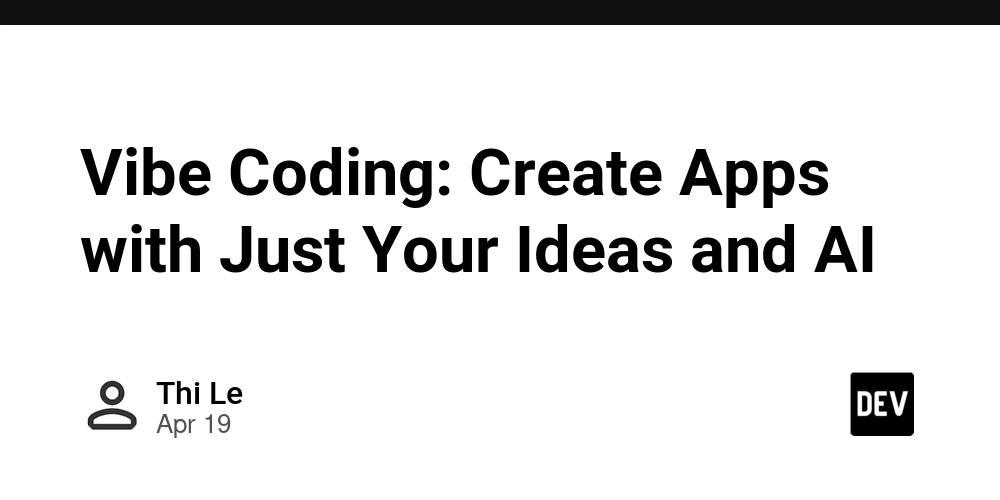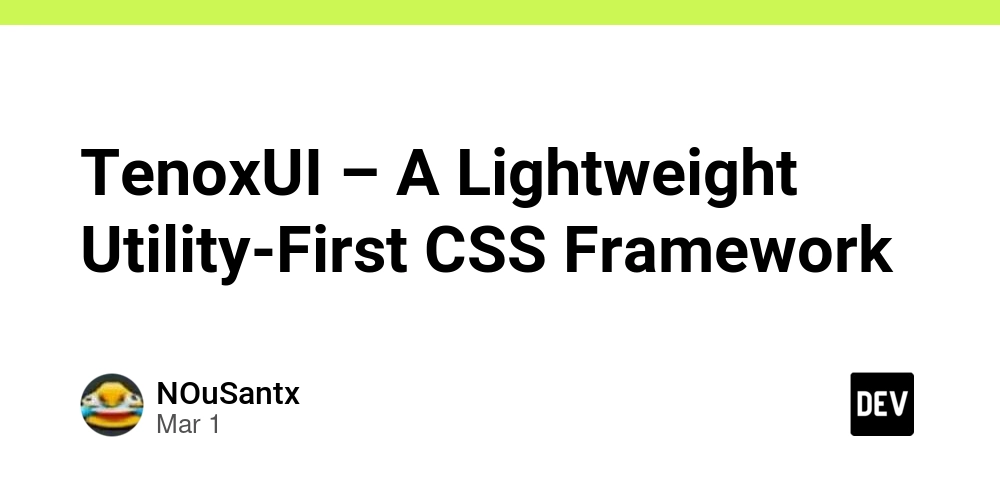Vibe Coding: Create Apps with Just Your Ideas and AI
Have you ever had a brilliant idea for an app but thought, "I can’t code, so it’s impossible"? What if you could just describe your idea, and an AI would build it for you? That’s the magic of vibe coding, a new trend that’s making software creation as easy as chatting with a friend. In this blog post, we’ll explore what vibe coding is, how it works, and why it’s exciting for beginners like you. Let’s jump in and see how AI is turning ideas into reality! What is Vibe Coding? Vibe coding is a way to create software by telling an AI what you want in plain English, instead of writing complex code. Imagine you’re telling a super-smart assistant, "Make me a website that shows local weather." The AI writes the code for you, and voilà—you’ve got a working app! The term was coined in February 2025 by Andrej Karpathy, a computer scientist and former AI leader at Tesla and OpenAI. He described it as "giving in to the vibes" and forgetting about the code itself, letting AI handle the technical stuff. It’s like painting a picture by describing the scene instead of picking up a brush. How Does Vibe Coding Work? Vibe coding is all about natural language prompts—you describe your idea, and an AI tool, like Cursor, ChatGPT, or GitHub Copilot, turns it into code. Here’s the simple process: Describe Your Idea: Say something like, "I want a to-do list app where users can add tasks and mark them as done." AI Generates Code: The AI, trained on tons of programming knowledge, writes the code for your app, including HTML, JavaScript, or Python, depending on what’s needed. Review and Tweak: You test the app. If something’s off (like a button not working), you tell the AI, "Fix the button," and it adjusts the code. It’s like having a coding partner who does the heavy lifting while you focus on the big picture. For example, a journalist used vibe coding to build an app called LunchBox Buddy, which suggests school lunch ideas based on fridge contents—all without writing a single line of code. Why Vibe Coding is Awesome Vibe coding is a game-changer for several reasons: No Coding Skills Needed: Anyone can create apps, from students to entrepreneurs, making software creation accessible to all. Super Fast: Instead of spending weeks learning to code, you can build a prototype in hours. Boosts Creativity: Focus on your ideas—like designing a unique app—without getting stuck on technical details. For instance, startups are using vibe coding to build apps quickly, with some creating entire codebases that are 95% AI-generated. It’s like having a turbo boost for your ideas! The Catch: Challenges of Vibe Coding While vibe coding is exciting, it’s not perfect: Bugs and Errors: AI-generated code can have mistakes, like a button that doesn’t click or a feature that crashes. Security Risks: If you don’t understand the code, you might miss security flaws, like vulnerabilities that hackers could exploit. One user built a web app with vibe coding, only to find it had security holes when tested online. Limited Control: Since you’re not writing the code, you might not fully understand how it works, making it hard to fix complex issues. Vibe coding is best for prototyping or fun projects, like a personal website or a simple game, rather than critical systems like banking apps. Real-World Uses of Vibe Coding Vibe coding is already making waves: Personal Projects: Non-coders are building tools like podcast summarizers or social media organizers. Startups: About 25% of new startups in 2025 used vibe coding to create apps quickly, saving time and money. Learning: Students use vibe coding to experiment with programming without getting bogged down by syntax, like training wheels for coding. For example, someone used vibe coding to create a tool that checks if furniture fits in their car trunk—super niche, but totally doable with AI. The Future of Vibe Coding Vibe coding is just getting started, and its future is bright: More Accessible Tools: As AI improves, vibe coding platforms like Replit will make it even easier for beginners to build complex apps. New Creators: Non-coders, like artists or small business owners, will create unique apps tailored to their needs, like custom booking systems for barbershops. Changing Coding: Vibe coding might shift programming from writing code to managing AI, making "English" the hottest programming language. Imagine a world where anyone can build an app as easily as writing a social media post. That’s the vibe coding revolution! Why You Should Try Vibe Coding Vibe coding empowers you to turn your ideas into reality without needing a computer science degree. It’s perfect for hobbyists, dreamers, or anyone who wants to experiment with tech. Plus, it’s fun to see your ideas come to life in just a few hours! Ready to give it a try? Start with a free tool like ChatGPT or Replit, and describe a simple app idea, like a quiz game

Have you ever had a brilliant idea for an app but thought, "I can’t code, so it’s impossible"? What if you could just describe your idea, and an AI would build it for you? That’s the magic of vibe coding, a new trend that’s making software creation as easy as chatting with a friend. In this blog post, we’ll explore what vibe coding is, how it works, and why it’s exciting for beginners like you. Let’s jump in and see how AI is turning ideas into reality!
What is Vibe Coding?
Vibe coding is a way to create software by telling an AI what you want in plain English, instead of writing complex code. Imagine you’re telling a super-smart assistant, "Make me a website that shows local weather." The AI writes the code for you, and voilà—you’ve got a working app!
The term was coined in February 2025 by Andrej Karpathy, a computer scientist and former AI leader at Tesla and OpenAI. He described it as "giving in to the vibes" and forgetting about the code itself, letting AI handle the technical stuff. It’s like painting a picture by describing the scene instead of picking up a brush.
How Does Vibe Coding Work?
Vibe coding is all about natural language prompts—you describe your idea, and an AI tool, like Cursor, ChatGPT, or GitHub Copilot, turns it into code. Here’s the simple process:
Describe Your Idea: Say something like, "I want a to-do list app where users can add tasks and mark them as done."
AI Generates Code: The AI, trained on tons of programming knowledge, writes the code for your app, including HTML, JavaScript, or Python, depending on what’s needed.
Review and Tweak: You test the app. If something’s off (like a button not working), you tell the AI, "Fix the button," and it adjusts the code.
It’s like having a coding partner who does the heavy lifting while you focus on the big picture. For example, a journalist used vibe coding to build an app called LunchBox Buddy, which suggests school lunch ideas based on fridge contents—all without writing a single line of code.
Why Vibe Coding is Awesome
Vibe coding is a game-changer for several reasons:
No Coding Skills Needed: Anyone can create apps, from students to entrepreneurs, making software creation accessible to all.
Super Fast: Instead of spending weeks learning to code, you can build a prototype in hours.
Boosts Creativity: Focus on your ideas—like designing a unique app—without getting stuck on technical details.
For instance, startups are using vibe coding to build apps quickly, with some creating entire codebases that are 95% AI-generated. It’s like having a turbo boost for your ideas!
The Catch: Challenges of Vibe Coding
While vibe coding is exciting, it’s not perfect:
Bugs and Errors: AI-generated code can have mistakes, like a button that doesn’t click or a feature that crashes.
Security Risks: If you don’t understand the code, you might miss security flaws, like vulnerabilities that hackers could exploit. One user built a web app with vibe coding, only to find it had security holes when tested online.
Limited Control: Since you’re not writing the code, you might not fully understand how it works, making it hard to fix complex issues.
Vibe coding is best for prototyping or fun projects, like a personal website or a simple game, rather than critical systems like banking apps.
Real-World Uses of Vibe Coding
Vibe coding is already making waves:
Personal Projects: Non-coders are building tools like podcast summarizers or social media organizers.
Startups: About 25% of new startups in 2025 used vibe coding to create apps quickly, saving time and money.
Learning: Students use vibe coding to experiment with programming without getting bogged down by syntax, like training wheels for coding.
For example, someone used vibe coding to create a tool that checks if furniture fits in their car trunk—super niche, but totally doable with AI.
The Future of Vibe Coding
Vibe coding is just getting started, and its future is bright:
More Accessible Tools: As AI improves, vibe coding platforms like Replit will make it even easier for beginners to build complex apps.
New Creators: Non-coders, like artists or small business owners, will create unique apps tailored to their needs, like custom booking systems for barbershops.
Changing Coding: Vibe coding might shift programming from writing code to managing AI, making "English" the hottest programming language.
Imagine a world where anyone can build an app as easily as writing a social media post. That’s the vibe coding revolution!
Why You Should Try Vibe Coding
Vibe coding empowers you to turn your ideas into reality without needing a computer science degree. It’s perfect for hobbyists, dreamers, or anyone who wants to experiment with tech. Plus, it’s fun to see your ideas come to life in just a few hours!
Ready to give it a try? Start with a free tool like ChatGPT or Replit, and describe a simple app idea, like a quiz game or a recipe organizer. Play around, tweak the results, and see what you can create. What’s an app you’ve always wanted to build? Share your ideas in the comments, and let’s vibe code together!









































































































































































![[The AI Show Episode 144]: ChatGPT’s New Memory, Shopify CEO’s Leaked “AI First” Memo, Google Cloud Next Releases, o3 and o4-mini Coming Soon & Llama 4’s Rocky Launch](https://www.marketingaiinstitute.com/hubfs/ep%20144%20cover.png)



























































































































![[DEALS] The All-in-One Microsoft Office Pro 2019 for Windows: Lifetime License + Windows 11 Pro Bundle (89% off) & Other Deals Up To 98% Off](https://www.javacodegeeks.com/wp-content/uploads/2012/12/jcg-logo.jpg)




























![Is this too much for a modular monolith system? [closed]](https://i.sstatic.net/pYL1nsfg.png)






















































































































_Andreas_Prott_Alamy.jpg?width=1280&auto=webp&quality=80&disable=upscale#)





























































































![What features do you get with Gemini Advanced? [April 2025]](https://i0.wp.com/9to5google.com/wp-content/uploads/sites/4/2024/02/gemini-advanced-cover.jpg?resize=1200%2C628&quality=82&strip=all&ssl=1)













![Apple Shares Official Trailer for 'Long Way Home' Starring Ewan McGregor and Charley Boorman [Video]](https://www.iclarified.com/images/news/97069/97069/97069-640.jpg)
![Apple Watch Series 10 Back On Sale for $299! [Lowest Price Ever]](https://www.iclarified.com/images/news/96657/96657/96657-640.jpg)
![EU Postpones Apple App Store Fines Amid Tariff Negotiations [Report]](https://www.iclarified.com/images/news/97068/97068/97068-640.jpg)
![Apple Slips to Fifth in China's Smartphone Market with 9% Decline [Report]](https://www.iclarified.com/images/news/97065/97065/97065-640.jpg)



































































































































